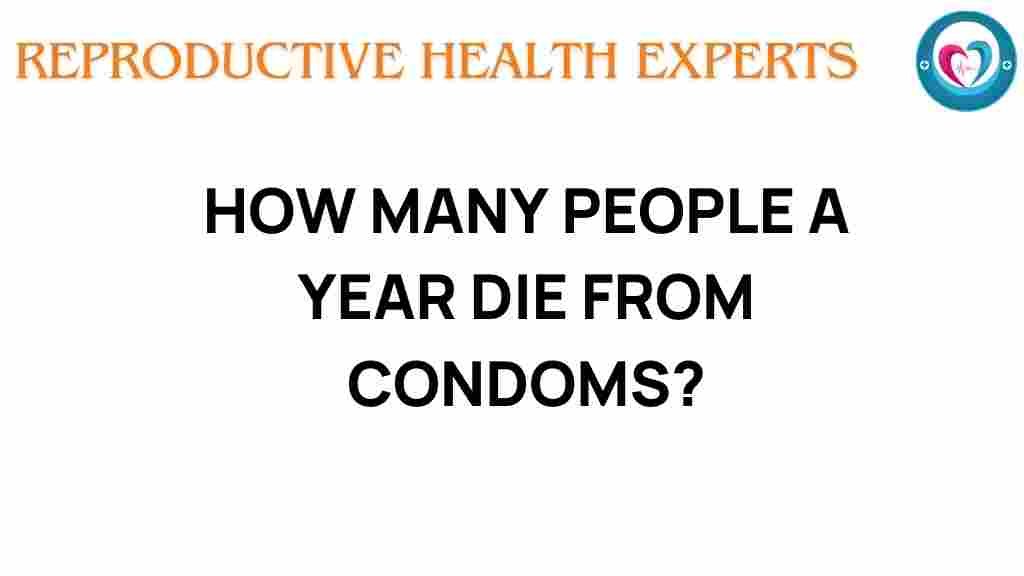Condom Safety: The Surprising Truth About Condom Deaths
When discussing sexual health, condoms often take center stage as a reliable method of preventing sexually transmitted infections (STIs) and unintended pregnancies. However, a question that occasionally arises is: how many people die from condoms each year? The topic may seem trivial at first, but examining the statistics surrounding condom safety reveals some surprising truths that are crucial for public health discussions.
This article will explore condom safety, the myths surrounding condom deaths, and the importance of sexual education in promoting healthy practices. We will delve into the health risks associated with improper condom usage, present safety statistics, and provide guidance on how to ensure safe sexual practices.
Understanding Condom Safety
Before diving into the statistics, it’s essential to understand what condom safety entails. Condom safety refers to the effectiveness of condoms in preventing STIs and pregnancy when used correctly. It also includes the proper handling, storage, and disposal of condoms to minimize any associated risks.
Myths and Misconceptions
One of the most significant misconceptions about condom usage is the belief that condoms can directly cause deaths. While there are rare occurrences where condoms have been linked to severe allergic reactions or accidents, these instances are not reflective of broader trends. Instead, most issues arise from misuse or lack of education regarding safe practices.
How Many People Die from Condoms Each Year?
To address the question directly: the number of deaths attributed directly to condom usage is exceedingly low. According to various health organizations, including the World Health Organization (WHO), there are no credible statistics indicating a significant number of deaths caused by condom use itself. Instead, most reported injuries or fatalities related to condoms stem from:
- Allergic reactions to latex or other materials
- Accidental choking or ingestion
- Improper usage leading to accidents during sexual activity
It is crucial to differentiate between direct condom-related deaths and those linked to the complications of unsafe sexual practices, which may not involve condoms at all.
Health Risks Associated with Condom Usage
While condoms are generally safe, improper usage can lead to various health risks. Here are some of the most common issues:
- Breach of Condom Integrity: If a condom is expired, damaged, or improperly stored, it can break during use, increasing the risk of STIs or unintended pregnancy.
- Allergic Reactions: Some individuals may experience latex allergies, leading to discomfort and potential health risks. Alternative materials, such as polyurethane or polyisoprene, are available for those with sensitivities.
- Improper Removal: Failing to remove a condom properly can lead to it being left inside the partner, which may cause infection or other complications.
- Misapplication: Applying a condom incorrectly can result in slippage or breakage, again increasing the likelihood of STIs or pregnancy.
Safety Statistics: Understanding the Numbers
When evaluating condom safety, several statistics are essential to consider:
- Effectiveness: When used correctly, condoms are 98% effective at preventing pregnancy and STIs.
- Breakage Rate: The typical breakage rate for condoms is about 1-2% when used correctly.
- Allergic Reactions: Latex allergies affect approximately 1-6% of the population.
These statistics highlight the importance of proper usage and education in maximizing condom safety. For more detailed statistics on sexual health, you can visit CDC’s Sexual Health Statistics.
The Role of Sexual Education in Promoting Condom Safety
Sexual education plays a crucial role in promoting condom safety. Comprehensive sexual education programs should cover:
- How to properly use condoms, including application and removal techniques
- The importance of checking expiration dates and storage conditions
- How to identify potential allergies and alternative options
- The significance of open communication with partners about sexual health
Such education can significantly reduce the risks associated with condom usage and improve overall sexual health outcomes.
Step-by-Step Guide to Safe Condom Usage
To ensure condom safety, follow this step-by-step guide:
- Check the Expiration Date: Before using a condom, check the packaging for the expiration date.
- Inspect the Packaging: Ensure the package is intact and undamaged.
- Open Carefully: Use your hands to open the package, avoiding sharp objects that could tear the condom.
- Apply Correctly: Pinch the tip of the condom to leave space for semen, then roll it down to the base of the erect penis.
- Use Lubrication: If needed, use water-based or silicone-based lubricants to reduce friction, but avoid oil-based products as they can degrade the condom.
- Remove Carefully: After ejaculation, hold the base of the condom while withdrawing to prevent spillage.
- Dispose Properly: Wrap the used condom in tissue and dispose of it in the trash, not the toilet.
Troubleshooting Tips for Condom Issues
Despite best efforts, issues may arise during condom usage. Here are some troubleshooting tips:
- If the Condom Breaks: Stop immediately and assess the situation. Use another condom if necessary, and consider emergency contraception if pregnancy is a concern.
- If You Experience Discomfort: Check for latex allergies or improper application. Consider switching to non-latex condoms.
- If a Condom Slips Off: Ensure to check the condom during and after intercourse. If it’s lost inside, see a healthcare provider for removal.
Conclusion: Prioritizing Public Health through Condom Safety
In conclusion, while the question of how many people die from condoms each year may provoke curiosity, the reality is that proper condom usage is overwhelmingly safe and effective when done correctly. The key to minimizing health risks associated with condoms lies in education and awareness. By promoting condom safety through comprehensive sexual health education, we can empower individuals to make informed choices that protect their health and well-being.
To further enhance your understanding of sexual health, consider exploring resources on public health initiatives focusing on condom usage and education. Remember, safe sex practices are integral to public health, and informed individuals are better equipped to navigate their sexual health journey.
This article is in the category Prevention and created by ReproductiveHealthExperts Team
